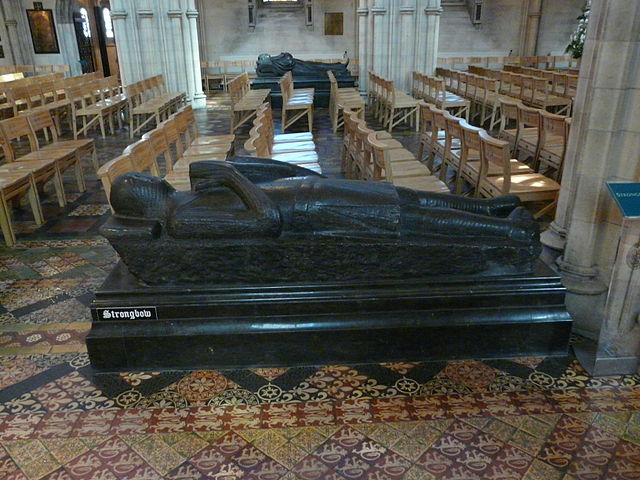
October 25, 2013, by Harry Cocks
Strongbow: the Anglo-Normans in Ireland
The first intervention of the Normans into Irish affairs resulted from a bitter local feud that, in 1171, allowed Henry II to become the first English monarch to set foot on Irish soil. This moment was portrayed by historians and writers of the early twentieth-century Irish national movement as a pivotal one: the first step in the long colonisation of Ireland by Britain. But a new book by the multiple award-winning author and Nottingham Centre for Advanced Studies Fellow Conor Kostick argues that Henry’s main motivation for arriving in Ireland was to prevent one of his own vassals becoming high king of Ireland. Richard fitzGilbert de Clare, known as Strongbow, (his interment is marked by the monument above, though the effigy is a replacement for the original destroyed by a falling roof) had formed an alliance with Diarmait Mac Murchada, the ousted king of Leinster. Despite a direct instruction against it, he had taken ship to Ireland, where his troops fundamentally shifted the balance of power in the country. Dr Kostick argues that this invasion was not necessarily a clash of two fundamentally different cultures or ethnicities, as it has usually been portrayed in the past, but that the coming of the Normans to Ireland saw a battle between two differing social systems. The Norman take-over of the eastern part of Ireland arose from their dynamic methods of rule. This in turn emerged from the social and economic structure of Normandy itself. From its foundation in 910, this region of northern France developed innovations in agriculture, social structure and warfare in which castle building and the use of cavalry came to the fore. Ireland, due to the importance of cattle to the economic foundations of society, had much greater emphasis on raiding and seizure of mobile wealth than on the control of land. Where the Normans could utilise their innovative military techniques to overcome their neighbours, they did so, and from Antioch, through Italy, to Sicily and England, Norman conquests transformed the local social systems. Strongbow can be seen as the last of the Norman adventurers, last, because not only were the adjacent societies catching up with Norman military prowess, but in their own realms, greater centralised authority was closing down the possibilities for ambitious lords. Dr Kostick argues that the coming of the Normans to Ireland is probably best viewed in the same light as the arrival of the Vikings some three hundred years earlier. It was a violent, dramatic period, full of political upsets and significant battles. But as the new arrivals settled, they fostered economic innovation. Moreover, while the Normans brought catastrophe to certain aristocratic Irish families, their conquest also had positive features, as they abolished slavery, which had been a major feature of Irish society.
Conor Kostick, Strongbow: The Norman Invasion of Ireland (O’Brien, 2013)
http://www.amazon.co.uk/Strongbow-The-Norman-Invasion-Ireland/dp/1847172008
No comments yet, fill out a comment to be the first

Leave a Reply